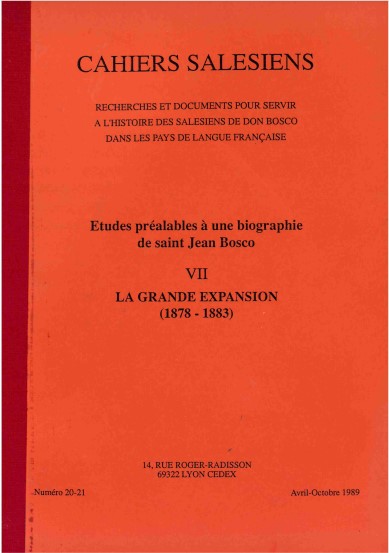Ce volume fait partie d’une collection de texts, écrits en français, qui racontent la vie de Don Bosco. Il couvre un arc temporel qui embrasse l’année 1844 jusqu’à 1852. En 1844 Saint Jean Bosco sort du Convitto ecclesiastico et dévient directeur spirituel d’un hôpital pour enfants dédié à Sainte Philomène. Don Cafasso a choisi ce poste pour lui. En octobre de cette année, son premier livre intitulé “Notes historiques sur la vie du clerc Luigi Comollo mort dans le séminaire de Chieri admiré par tous pour ses vertus singulières” sort. Il s’agit d’un opuscule dédié à son ami décedut Luigi Comollo et s’adresse à un public précis: aux “signori seminaristi di Chieri”, pour leur édification. Un événement très important à cette époque fut l’installation de l’Oratoire de Saint François de Sales qui fonctionne de décembre 1844 à julliet 1845. Au cours de l’année 1845 il publie deux livres: 1) “Il Divoto dell’Angelo Custode” (le Dévot de l’Ange Gardien). Il s’agit d’une neuvaine préparation à la fête des saints anges gardiens 2) “Storia ecclesiastica ad uso delle scuole utile per ogni ceto di persone”. Le Saint commence à avoir une santé fragile et en juillet 1846 il tombe malade. Ensuite il publie deux livrets de pieux exercices: le “Giovane provveduto” et la “Storia Sacra”. Pendant le “Risorgimento”, Don Bosco se refuse de laisser entraîner son Oratoire S. François de Sales dans un cortège patriotique de reconnaissance au souverain réformateur et perd ainsi l’appui de Roberto d’Azeglio et l’aide de plusieurs laïcs et ecclésiastiques. Dans ses “Memorie dell’Oratorio”, il nomme plusieurs attentats contre sa personne. Il va écrire un “Plan de règlement” pour l’Oratoire S. François de Sales divisé en deux parties: la prèmiere est destinée à l’encadrement, la deuxième surtout aux enfants. En 1849 Amedeo Bert, aumônier des légations des pays protestants, publie une ouvrage qui présent l’histoire des vaudois, données pour victimes de la méchanceté et de la brutalité catholiques. Cette publication va heurter le camp opposé, y compris Don Bosco. Aux yeux du Saint, les vaudois ne constituaient qu’une secte d’hérétiques. En 1850 une apologie antivaudoise “Avvisi ai cattolici” et une deuxième “Il cattolico istruito nella sua religione” en 1853, écrites par Don Bosco, sortent.






